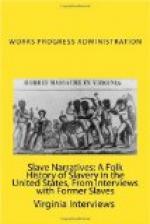When Mrs. Preston was a little older part of her work was to drive about a dozen cows to and from the stable. Many a time she warmed her bare feet in the cattle bedding. She said they did not always go barefooted but their shoes were old or their feet wrapped in rags.
Her next promotion was to work in the fields hauling shocks of corn on a balky mule which was subject to bucking and throwing its rider over its head. She was aided by a little boy on another mule. There were men to tie the shocks and place them on the mule.
She remembered seeing Union and Confederate soldiers shooting across a river near her home. Her uncle fought two years, and returned safely at the end of the war.
She did not feel that her Master and Mistress had mistreated their slaves. At the close of the war, her father was given a house, land, team and enough to start farming for himself.
Several years later the Ku Klux Klan gave them a ten days notice to leave, one of the masked band interceded for them by pointing out that they were quiet and peacable, and a man with a crop and ten children couldn’t possibly leave on so short a notice so the time was extended another ten days, when they took what the Klan paid them and came north. They remained in the north until they had to buy their groceries “a little piece of this and a little piece of that, like they do now”, when her father returned to Kentucky. Mrs. Preston remained in Indiana. Her father was burned out, the family escaping to the woods in their night clothes, later befriended by a white neighbor. Now they appealed to their former owner who built them a new house, provided necessities and guards for a few weeks until they were safe from the Ku Klux Klan.
Mrs. Preston said she was the mother of ten children, but now lives alone since the death of her husband three years ago. Her white neighbors say her house is so clean, one could almost eat off the floor.
Federal Writers’ Project
of the W.P.A.
District #6
Marion County
Harry Jackson
William M. Quinn (ex-slave)
431 Bright Street, Indianapolis, Ind.
William M. Quinn, 431 Bright street, was a slave up to ten years of age—“when the soldiers come back home, and the war was over, and we wasn’t slaves anymore”. Mr. Quinn was born in Hardin County, Kentucky, on a farm belonging to Steve Stone. He and a brother and his mother were slaves of “Old Master Stone”, but his father was owned by another man, Mr. Quinn, who had an adjoining farm. When they were all freed, they took the surname of Quinn.
Mr. Quinn said that they were what was called “gift slaves”. They were never to be sold from the Stone farm and were given to Stone’s daughter as a gift with that understanding. He said that his “Old master paid him and his brother ten cents a day for cutting down corn and shucking it.”




